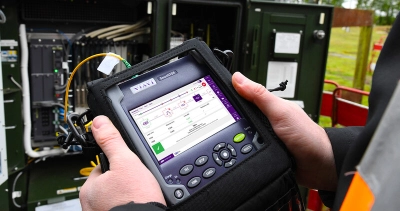The use of ofda optimizes fibre evaluation with advanced optical technology.
Discovering the Conveniences of Optical Fiber Checking for Boosted Interaction Systems
The importance of optical fiber screening in modern communication systems can not be overemphasized, as it functions as a foundation for making certain network dependability and performance. Using innovative approaches such as Optical Time-Domain Reflectometry (OTDR) and insertion loss evaluation, organizations can not only determine mistakes yet likewise optimize their arrangements. This positive screening method has profound ramifications for signal high quality and functional effectiveness, increasing the concern of how these methods add to lasting sustainability in an ever-evolving technical landscape. Recognizing these characteristics is crucial for stakeholders intending to keep an affordable side.
Importance of Optical Fibre Screening
The importance of optical fiber testing can not be overstated in today's data-driven setting. As organizations increasingly count on high-speed data transmission for everyday operations, the honesty and efficiency of optical fiber networks are critical. Checking makes sure that these networks can sustain the large amounts of data generated and sent flawlessly, promoting reliable communication and connection.
Optical fibre screening offers numerous vital features, consisting of confirming installation quality, determining prospective faults, and determining total system performance. Normal screening can protect against expensive downtimes and service disruptions, permitting organizations to maintain operational connection. It aids in conformity with industry standards and policies, making sure that fiber optic installations satisfy required specifications for safety and integrity.
Additionally, testing can enhance the longevity of fibre optic systems. By proactively determining issues such as signal loss, depletion, or connector failures, organizations can deal with problems prior to they intensify, thus prolonging the life of their framework. In recap, optical fiber screening is not merely a technical demand however a critical financial investment that improves network reliability, enhances performance, and ultimately supports the growth and efficiency of modern-day communication systems.
Key Testing Techniques

OTDR is an essential method made use of to identify faults, step splice losses, and analyze the general honesty of a fibre optic web link. By sending a pulse of light down the fibre and examining the reflected light, service technicians can determine areas of faults and assess the network's efficiency over cross countries.
Insertion loss testing gauges the quantity of signal loss that happens when light travel through a link or splice. This method is essential for confirming that connections satisfy given loss limits, which is vital for preserving optimal efficiency in interaction systems.
Optical return loss testing quantifies the amount of light mirrored back towards the resource because of flaws in the fibre or links. High return loss worths suggest much better performance and important link reduced signal destruction.
Together, these testing methods provide a comprehensive evaluation of fibre optic networks, ensuring their dependability and functionality in diverse interaction applications.
Influence on System Efficiency
Reliable optical fiber screening directly influences the total performance of interaction systems. By guaranteeing the integrity of fibre optic wires, screening identifies possible faults such as depletion, splice loss, and port misalignment. These problems can considerably degrade signal top quality, bring about disruptions and lowered data transmission speeds.

Additionally, routine optical fibre testing adds to long-term system sustainability. It makes it possible for early discovery of deterioration, enabling for timely maintenance a knockout post and upgrades prior to major failures take place. This not only lengthens the life-span of the framework but additionally makes sure that interaction systems remain affordable in terms of performance.
Cost-Effectiveness and Performance
Cost-effectiveness is a crucial consideration in the deployment and upkeep of optical fiber networks. Carrying out robust optical fiber testing treatments can considerably decrease functional costs by identifying problems prior to they escalate into major issues. optical fibre testing equipment. By finding faults, attenuation, and other performance barriers early, companies can stay clear of costly repair services and downtime, which can interfere with solutions and result in profits loss
Furthermore, effective screening techniques simplify the installment process, allowing specialists to work a lot more properly. This translates to reduce work expenses and faster task conclusion times. Advanced testing tools, such as Optical Time Domain Name Reflectometers (OTDRs), enables an exact evaluation of fibre top quality, ensuring that just optimal products are used, thus reducing waste.
Regular testing additionally adds to better resource allowance. By comprehending the network's performance, companies can make enlightened decisions about upgrades and expansions, making sure that investments are made where they are most needed. In he said recap, optical fiber screening enhances cost-effectiveness and effectiveness, supporting the long-term sustainability and competitiveness of communication systems in a significantly requiring market.
Making Certain Long-Term Reliability
Applying strenuous optical fibre screening not just enhances expense financial savings and functional effectiveness however also plays a crucial function in making certain the long-term reliability of communication networks. Consistent screening methods, consisting of attenuation and bandwidth evaluations, assistance identify prospective deterioration in fiber performance before it brings about service disturbances.
By utilizing innovative testing methods, network drivers can identify mistakes or weak points in the fibre facilities, enabling timely removal. This proactive method reduces downtime, making certain that interaction systems remain functional and reliable. In addition, normal testing adds to the development of an extra resilient network, as operators can adjust and optimize their framework based on real-time data insights. optical fibre diameter analyser.
Furthermore, making certain compliance with sector requirements through optical fiber screening reinforces the quality and stability of the entire interaction system. This adherence not only boosts self-confidence among stakeholders however additionally aligns with regulatory requirements, which are increasingly strict.
Final Thought
In verdict, optical fibre testing serves as a fundamental component in enhancing interaction systems. By using different testing methods, such as OTDR and insertion loss assessments, networks can achieve optimal efficiency and reliability.